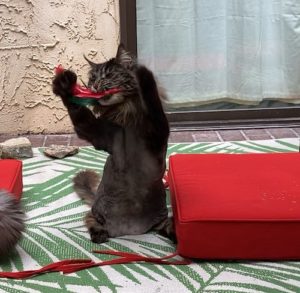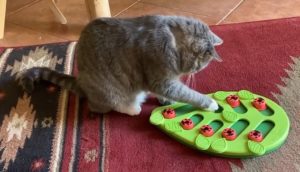
Providing opportunities for predatory play is one of the components of a cat-friendly home. Like people, cats are individuals, with different tastes and experiences. This certainly is one reason for the large variety of cat toys at the pet store. But what if your cat does not want to play?
Some cats like to play more than others
A group of researchers observed the responses of 31 cats to toy balls, a fishing pole style toy with a soft bird shaped toy at the end, and recorded sounds of a chirping bird, a squeaking mouse, crumpled paper and a rustling plastic bag. Thirteen of these cats were indoor-outdoor cats; the remaining 18 were indoor-only cats.
What did they find out?
- Indoor-only cats touched or played with balls sooner than indoor-outdoor cats.
- Indoor-only cats started searching earlier for playback sounds (chirping, squeaking etc) than the indoor-outdoor cats.
Why do indoor-only cats like to play more than outdoor cats?
The two groups of cats had close relationships with their owners: the main difference was that one group had access to the outdoors.
The indoor-outdoor cats most likely had experience with actual prey animals. Live prey can “fight back” and cause injury to the hunter, so a slower, more cautious approach may be smarter. The indoor-only cats don’t “know any better” and showed a more intense interest in and faster response to “simulated prey”, not having had any negative experience with hunting things.
Should I try to play with my indoor-outdoor cat?
Yes, play with your indoor-outdoor cat. Play is part of the regular, positive interactions we have with our cats. The need to hunt defines who your cat is – this is what he was born to do. Although he gets a lot of stimulation while outdoors, a short, regular play time helps reinforce the cat-owner bond.
It may be a bit more difficult to find that thing he’ll play with, compared to an enthusiastic indoor-only cat.
My experience with “Gus, A former street cat”
- Gus has always enjoyed “treat toss” ( I throw dental treats for the cats to chase and eat).
- He is not interested in the feather and mice toys at the end of a wand.
- He occasionally plays with catnip toys and balls.
- After two years, he has agreed to chase a pair of tied-together shoe laces down the hall and has his own preferred food puzzle.
My indoor-only cat just won’t play with anything
Cats are individuals and some cats like to play more than others. Yes, try to entice your cat to play. It can take longer to find out what some cats will play with. It may take a few tries before they become interested enough to chase that shoelace, mouse toy on a wand or the crumpled ball of paper you throw down the hallway. If the cat walks away, then try again another day.
- A play session around the same time everyday lets them know what is going to happen.
- Be alert to possible frustration – your cat needs some reinforcement intermittently to keep her playing the game.
- Use the laser pointer to point to a treat when ending the laser tag session.
- Let her catch the toy on the wand and chew on it occasionally during a play session.
- End the play session with a game of “treat toss”.
Playing with more than one cat
Even if cats are not part of the same social group , they can still manage a joint play session. Cats are good at “time-sharing” – taking turns while another cat plays. Often they will have different preferences, so they will wait for “their toy”. Cats are often very willing to wait if there is a treat session at the end (after all, hunting requires patience!)
The importance of predatory play…
It is true that some cats like to play with toys or chase treats more than others. But every cat has a hunting heritage and helping him use it strengthens the bond between you and your cat.
Tips for playing with cats
Play and Treat time is a meal
- Cats do better physically and emotionally eating multiple small meals daily.
- Restricting access to food (meal feeding) can make treat time a bit more special.
- Include the treats in your cat’s daily calorie count.
Play and treat time – a positive, predictable interaction for your cat
- Cats like to play with a variety of toys – have several boxes of toys that you rotate.
- Marinate some of the toys in catnip or silvervine.
- Play sessions do not need to be more than 5 minutes or so per cat.
- Put all interactive toys away when playtime is over.


